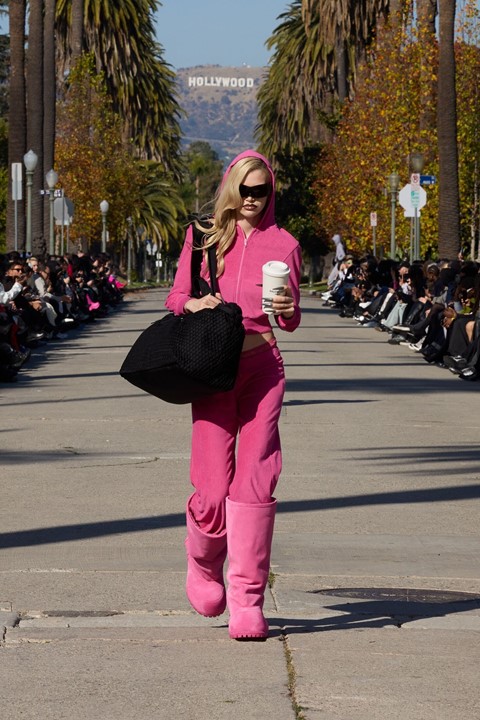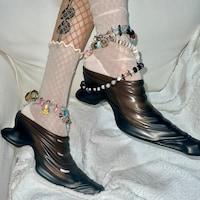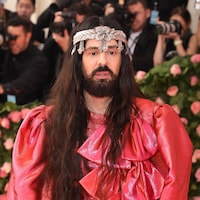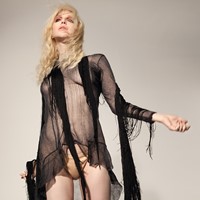With creatives flocking from the East coast and endorsements from heavyweights like Balenciaga and Chanel, a new hub for American fashion appears to be emerging
Is New York Fashion dead? It’s a question that has occupied everyone from TikTokers to bloggers and even Cathy Horyn. In a conversation between the renowned American fashion critic and Tim Blanks for System, Horyn lamented: “It’s shocking how much it has declined. Calvin, Ralph, Donna Karan seems like a golden age… and I don’t see anything positive in the future of New York.”
You can blame this slump on a multitude of things: the rise in influencers squandering the city’s prestige, the lack of legacy brands on the schedule, oversaturation leading to less excitement, and the brunches, activations, and pop-ups that swarm the city that actually have nothing to do with fashion. It’s become a limp circus for social media, one that’s overshadowing the clothing, with a few stalwarts like Michael Kors and Kelly Cutrone carrying the torch.
All of this has led to many American designers seeking greener pastures. Paris has emerged as the golden ticket to fashion prestige and over and over again, as designers like Vaquera, The Row, and Peter Do eschew the Big Apple for something a little more promising. But for those who want to stick to US soil, Los Angeles is quickly emerging as a new, exciting possibility.
The City of Angels is home to Hollywood, the Kardashians, Goop luncheons, and everything else that people love and hate about America. It’s all concentrated in this vast city full of paradoxical multitudes – rapidly rising rates of homelessness and Selling Sunset – that people still fervently flock to in the hopes to make their dreams come true.
Over the last few years, a lot of blood, sweat, and dollars have been invested in establishing LA as a fashion hub. Especially with the overhaul of LAFW by N4XT Experiences, a company founded by Ciarra Pardo, former chief creative officer of Fenty alongside Imad Izemrane, president and co-founder of Spring Place (the host of NYFW for the last eight years). Since acquiring the fledgling fashion week brand, Pardo – a native New Yorker who has now lived in LA for 20 years – has been hellbent on revitalising it and bringing the event to a global stage. Despite LAFW being first launched two decades ago, it’s only been recognised by the CFDA under Pardo’s leadership.
This year – its second led by N4XT – the LAFW schedule boasted an impressive onslaught of local, international, and even New York talent. Sergio Hudson, Theophilio, Luis de Javier, Kwame Adusei, No Sesso, Imitation of Christ, Gypsy Sport, and others presented collections, while Kim Shui and Jonathan Simkhai rounded out the experience with fireside chats.
“Our involvement over the last two years has been instrumental in elevating LA’s status in the fashion world by showcasing local talent, fostering unique aesthetics, and highlighting the city's diverse culture.” – Ciarra Pardo, N4XT Experiences co-founder
At the premiere of his short film during the event, which recounted TOMBOGO’s journey to PFW, California-native Tommy Lederer-Pon made an impassioned plea to the small theatre packed with friends, investors, and journalists to put LA on the map. “There is a feeling of freshness and excitement showing in LA,” Lederer-Pon tells Dazed. “It’s cool to see this happening so close to home. There are so many talented designers in LA, not to mention all the manufacturing resources and skilled workers that are based out here. There are a lot of ways that LA has deeply impacted the fashion industry, so seeing it get the recognition feels right.”
Pardo credits N4XT and LAFW for this change. “Our involvement over the last two years has been instrumental in elevating LA’s status in the fashion world by showcasing local talent, fostering unique aesthetics, and highlighting the city’s diverse culture.”
This year, Chanel presented an “ode to the City of Angels” with its Cruise 2024 collection at Paramount Studios. This coincided with the opening of its new boutique in Beverly Hills, the largest in the US. Earlier this month, Balenciaga captivated audiences with its own homage to LA, a runway show filled with celebrities on and off the front row, alongside a collaboration with the infamously-overpriced wellness market, Erewhon. It was a veritable wet dream for high fashion, overpriced smoothie lovers everywhere, and laid out an interesting playbook for anyone wanting to make a splash in the US.
“These brands are undoubtedly celebrity-driven, appealing to the masses or shoppers who love luxury but aren’t intertwined in the fashion world, and have the budget to create a spectacle,” explains fashion writer, director, and forecaster Kendall Becker. “Los Angeles acts as a much better canvas for drawing this type of attention rather than New York.”
“These brands are undoubtedly celebrity-driven, appealing to the masses or shoppers who love luxury but aren’t intertwined in the fashion world, and have the budget to create a spectacle. Los Angeles acts as a much better canvas for drawing this type of attention rather than New York.” – Kendall Becker
Alexandra Hildreth, a fashion writer and TikToker, contends that LA might make sense as a headline-grabbing destination but that does not make it a fashion capital. “The brands that have shown – Balenciaga, Chanel, Celine, Versace – look at LA as an equivalent to Prada showing in Shanghai, Jacquemus in Hawaii, rather than trying to transfer to LA as a fashion flagship.”
“Chanel just had a show in Manchester, but nobody is talking about Manchester becoming the next it-city,” quips Russian-born, New York-based photographer Sasha Eck. “Showing in LA gives more legitimacy to the brand rather than the city, because it becomes a question of “where will the next show be?”
“A lot of the non-celebrities who attended the Balenciaga show flew out specifically for it,” Hildreth adds. These non-celebrities refer to the gaggle of journalists, it-girls, and industry professionals that made the pilgrimage to LA for Demna Gvasalia’s spectacle.
Edvin Thompson, designer and creative director for New York brand Theophilio, put on one of the most sought-after shows on the LAFW calendar in 2023. He tells me that if LA were to successfully establish itself as a global fashion hub, it would be “refreshing,” however, his concern is actually the lack of “non-celebrities” Hildreth pointed to. “In New York we have the headquarters of major media companies that house the biggest fashion publications in the world. Los Angeles simply doesn’t have that and I think that’s a big reason as to why it hasn’t [been recognised] yet. The more people read about LA as a potential fashion capital the more they can come to accept it.”
What LA lacks, at least for designers, is made up for by a slew of things that it does better. Mike Cherman, the founder of streetwear brand Market, was born and raised in New York, but for him, this slow exodus from NY to LA is bigger than the industry. “I think people are just choosing quality of life over everything. Maybe they’re sacrificing some of the ease and speed of living in New York but there’s something to be said about having a little bit of peace in your mind.”
Cherman compares balancing boxes of clothes on the handles of his bike as he rode it over the bridge in New York to simply driving in LA. After all, having a car in New York is only for the city’s bravest residents, but it’s not impossible. However, there’s nothing you can do in the city to counter LA’s manufacturing prices and access to wholesale factories. “When I first came here it felt almost like… Not to sound cheesy, but like the land of opportunity,” Cherman continues. “In New York that’s really hard to find.”
The cost of creating clothes in New York is undeniably prohibitive. “It’s impossible to create clothing in New York City because you’re paying garment district rent prices first and foremost,” Elena Velez told Dazed earlier this year. “The overhead here is impossible to compete with.”
Despite the consistently sunny weather, manufacturing prices, quality of life, and Hailey Bieber smoothies, there’s still a vehement reluctance to embrace LA by many. There’s a sickly saccharine aftertaste that can linger from the celebrity culture and glamour that is antithetical to New York’s admittedly cool nonchalance and hard edge.
Valerie Campbell, the designer and co-founder of cult LA label, Freak City thinks this could all be overcome by looking past LA’s fantastical facade. “From the outside, it can look really obnoxious, but LA has some of the richest cultures and subcultures. So far, these fashion houses have only given us: ‘I went to LA for a week, stayed on the Westside, went to Erewhon everyday, went hiking twice, had lattes every morning, and enjoyed dinner at Soho House. This is their impression of the LA bitch lifestyle.”
Campbell’s insistence to seek out more authentic stories makes sense; in the same way that the world learned about New York fashion beyond Gossip Girl glamour, by diving into the heart of Brooklyn, Harlem, Queens, and the Bronx through designers like Luar, Telfar, Christopher John Rogers, Head of State, HBA, and Puppets and Puppets. The far more interesting stories lay undiscovered under a pile of BBLs and Juicy Couture sweatsuits.
“It would be positive for the US to have more than one fashion capital. It’s good to profit from the differences between both cities, and having two different manifestations of what American fashion can be.” – Constanza Orlowski
“I think it’s a good thing that American fashion is decentralising from New York,” Constanza Orlowski, a young Argentinian, New York-based fashion designer relents.
It’s clear that US fashion desperately needs to be revitalised. Horyn might think New York is over, but Orlowski thinks that reaching across the country and working in tandem is probably the best solution. “It would be positive for the US to have more than one fashion capital. From an industrial and cultural perspective, bringing back manufacturing to the US would create more job and artisanal apprenticeship opportunities. It would make American fashion more competitive with two centres as opposed to just one. It’s good to profit from the differences between both cities, and having two different manifestations of what American fashion can be.”




